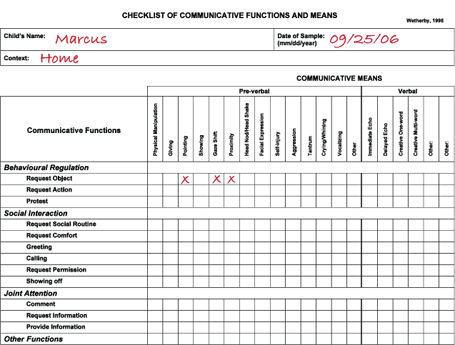by Amy M. Wetherby, 1995
Children who are not yet using much speech often communicate in many other ways. This checklist is useful in determining how and when your child communicates. Each “Communicative Function” or reason for communicating may be expressed using any number of “Communicative Means” or ways to communicate through actions and behaviour.
Communicative Functions (Reasons to Communicate)
The Communicative Functions (reasons to communicate) are divided into the following categories:
- Behavioural Regulation: actions used to get, or refuse, something (e.g., child asks for a toy airplane by pointing to it)
- Social Interaction: actions used to get another’s attention (e.g., child waves to say “Hello”)
- Joint Attention: actions used to direct another’s attention to share information (e.g., child points to an airplane in the sky to show it to you)
Communicative Means (Ways to Communicate)
The Communicative Means (ways to communicate) are divided into two sections called Pre-verbal and Verbal. The following is a brief description of each way or action listed in the checklist.
Pre-verbal (ways of communicating other than using words)
- Physical Manipulation – touching, trying to operate a toy
- Giving – giving an item to another person for a specific purpose (e.g., to request help with activating the item, or to express an interest in it)
- Pointing – pointing to an item for a specific purpose
- Showing – showing the item, but not giving it
- Gaze Shift – looking briefly in the direction of an item out of interest
- Proximity – moving closer to the item out of interest, or away from it in protest
- Head Nod/Head Shake – indicating interest in an object through nodding, or protesting by shaking head
- Facial Expression – smiling, frowning, etc.
- Self-Injury – hitting, biting, banging self
- Aggression – hitting, biting, punching, kicking, scratching others
- Tantrum – screaming, throwing self down on floor
- Crying/Whining – to make needs known
- Vocalizing – any speech-like sounds that are not full words
- Other – word approximations such as “bu-bu” for “bubble”
Verbal (ways of communicating using words)
- Immediate Echo – child repeats what is heard immediately after hearing it
- Delayed Echo – child repeats what was heard earlier in the day or on a previous day
- Creative One-word – uses a single word not in imitation of something heard, (e.g., saying the word “milk” can be to request it, to comment on seeing or having it, or to ask if that is what is in a cup)
- Creative Multi-word – uses two or more words not in imitation of something heard
How to use the checklist
To use the checklist, simply go through each Communicative Function and check off the Communicative Means that apply. For example, if your child requests objects by pointing, looking, and moving closer to them, you would check off all three of these pre-verbal means in the “request object” row.
Here’s an example:

Once you have completed the checklist, you will see which ways are most often used by your child to communicate. You may also notice ways and reasons for communicating that need work. For example, the child in the above checklist communicates gesturally (e.g., pointing, eye gazing, and proximity) to request objects. Therefore, communication goals for him could include using head nod or vocalizing to request objects. We always want to expand both the ways and reasons that your child communicates. Remember that once you know how your child communicates, it is easier to figure out what the next step should be.
